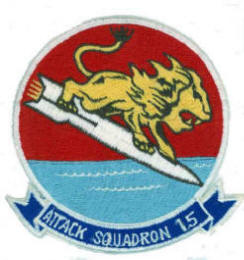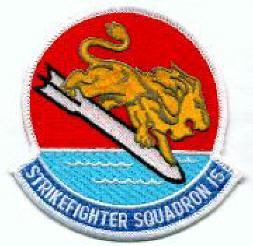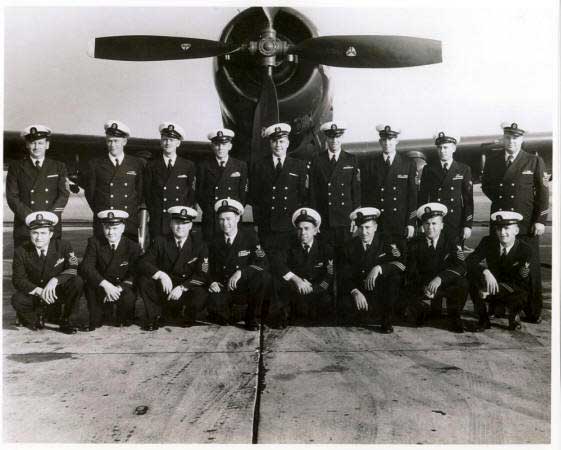VA-15 Lineage
- Established as Torpedo Squadron FOUR (VT-4) on 10 January 1942.
- Redesignated Attack Squadron TWO A (VA-2A) on 15 November 1946
- Redesignated Attack Squadron FIFTEEN (VA-15) on 2 August 1948.
- Disestablished on 1 June 1969. The first squadron to be assigned the VA-15 designation.
VA-15 Insignia

The squadron’s insignia was approved by BuAer on 22 April 1942.
The theme of the insignia was VT-4 sweeps the seas. The lion represented the squadron’s TBD-1 Devastator, and the six teeth were for the number of Devastators assigned to it. Colors in the insignia were as follows: circular outline in black; background white; the sea a deep blue with pale blue marks, torpedo pearl gray with black outline and marks; lion ocher outlined in black with black markings; white eyes outlined in black with black pupils; nose black; teeth white, lips and mouth red; and the broom was lemon yellow outlined in black with red dashes on lower part of broom.
There is no record of VA-2A’s changing the insignia following its redesignation from VT-4. Three years after the squadron was redesignated, VA-15 requested a modification to the old VT-4 insignia. On 19 September 1951, CNO approved the modification. The lion was retained to represent the strong attack capabilities of the squadron and the torpedo was replaced by a missile. The background color of the upper half of the insignia was red to represent the flames of past targets, and the lower half was blue to indicate water and the squadron’s carrier-based capabilities.
Other insignia colors included a white circular border; lion in gold with brown markings; and the missile and ripples in the water white. This insignia remained with VA-15 until it was disestablished in 1969
Nickname: Valions, mid-1950s–1969.
VA-15 Chronology
- 10 Jan 1942: Torpedo Squadron FOUR (VT-4) was established aboard Ranger (CV 4) while the ship was in port at Grassy Bay, Bermuda.
- 8 Aug 1943: Ranger, with VT-4 aboard, met the convoy with the liner Queen Mary, which was bringing Winston Churchill to North America for the Quebec Conference.
- Aug–Nov 1943: VT-4, while deployed aboard Ranger, operated as part of the British Home Fleet.
- 4 Oct 1943: The squadron participated in Operation Leader and struck at shipping targets around Kunna Head, Norway, while other elements of CVG-4 struck targets at Bodo, Norway. The squadron’s TBF-1 Avengers, along with its escort of F4F Wildcats, destroyed a German freighter and a small coaster and damaged a troop transport.
- Oct 1943: VT-4, flying from Ranger, operated with the British Second Battle Squadron and patrolled the waters of the Norwegian Sea.
- 1 May 1944: CVG-4 reformed as a spare air group with a composition that was designed to include 36 fighter aircraft (F6F), 36 scout-bomber aircraft (SB2C) and 18 torpedo aircraft (TBF/TBM). This air group composition was organized to operate from the large deck carriers of the Essex class. Squadrons in CVG-4 included VT-4, VF-4 and VB-4. This change also brought an end to Air Group FOUR’s operations aboard Ranger.
- Jul 1944: VT-4 and CVG-4 transferred from Atlantic to Pacific Fleet.
- 15–21 Jul 1944: VT-4 aboard Barnes (CVE 20) enroute to Pearl Harbor from San Diego.
- 21 Sep 1944: During a pre-dawn sortie involving simulated torpedo tactics, three of the squadron’s aircraft collided with each other, resulting in the loss of nine personnel, including the squadron’s commanding officer, Lieutenant Commander Homer H. Hutcheson.
- 4–17 Nov 1944: CVG-4 and VT-4 were temporarily embarked on Bunker Hill (CV 17) for operations in support of landings at Leyte. The squadron participated in combat strikes at Ormoc Bay, Cavite and Clark Field.
- Dec 1944: The squadron participated in combat operations in support of landings on Mindoro.
- Jan 1945: While operating from Essex (CV 9), the squadron struck targets on Formosa, Luzon, Hainan and the Ryukyu Island chain as well as in French Indochina (Vietnam). Operations in Vietnam were around Saigon and Camranh Bay. These operations were in support of the continued assault against the Japanese in the Philippines.
- 16 Feb 1945: The squadron conducted its first strikes against the home islands of Japan, hitting Mawatari airfield on Honshu. Other strikes against targets on Honshu were conducted on 17 and 25 February.
- 19–22 Feb 1945: CVG-4 provided support for landings on Iwo Jima.
- 1 Mar 1945: The airfield, facilities and shipping at Naha, Okinawa, were hit by squadron aircraft.
- 4 Mar 1945: VT-4 disembarked from Essex at Ulithi completing the squadron’s last combat cruise during World War II.
- 9–23 Mar 1945: CVG-4 aboard Long Island (CVE 1) for passage from Ulithi to Pearl Harbor. VT-4 eventually returned to the States in April 1945 for reforming following its combat cruise.
- 15 Feb–15 Apr 1946: VT-4 along with other squadrons in CVG-4, participated in Tarawa’s (CV 40) shakedown cruise in the Caribbean Sea following the ship’s commissioning in December 1945.
- Nov 1946: Some squadron aircraft were fitted with sonobuoy gear and personnel were trained in antisubmarine missions as well as their normal torpedo-attack requirements.
- 22 May 1950: VA-15, along with the other squadrons in CVG-1, were designated as training squadrons and CVG-1 as a training air group. The squadron’s primary mission was the training of fleet pilots in attack aircraft. VA-15’s training syllabus emphasized glide bombing, dive-bombing, rocket firing, day-and-night tactics and carrier qualifications in the AD Skyraider.
- 13–23 Sep 1952: VA-15, while deployed aboard Wasp (CVA 18), participated in the first NATO naval operation, Operation Mainbrace, conducted in the North Atlantic.
- Feb 1955: While deployed aboard Midway (CVA 41), the squadron supported the evacuation of Chinese Nationalist civilians and military personnel from the Tachen Islands which were being bombarded by the People’s Republic of China.
- Nov–Dec 1956: As a result of the Suez Crisis, VA-15 deployed aboard Forrestal (CVA 59) and operated in the vicinity of the Azores.
- 12 Sep 1958: VA-15 was assigned the additional mission of in-flight refueling (Buddy Stores).
- 14–28 Nov 1960: VA-15, temporarily assigned to CVG-10, deployed aboard Shangri-La (CVA 38) to the Caribbean Sea to guard against possible infiltration into Guatemala and Nicaragua by insurgent organizations that were believed to have ties to Cuba.
- 21–27 Nov 1961: VA-15, embarked in Franklin D. Roosevelt (CVA 42), operated off the coast of the Dominican Republic to support the newly established democratic government.
- Mar–Apr 1962: VA-15 deployed aboard Enterprise (CVAN 65) to the Caribbean and participated in the shakedown cruise of the world’s first nuclear powered carrier.
- Aug 1965: VA-15 began training under VA-44 for transition to the A-4 Skyhawk.
- 4 Apr–21 Nov 1966: VA-15 deployed to Vietnam as a component of CVW-10 embarked on Intrepid (CVS 11). CVW-10 was an all-attack air wing comprised of four attack squadrons, two squadrons flying A-4 Skyhawks and two squadrons with A-1 Skyraiders.
- 15 May 1966: The squadron flew its first combat mission since March 1945 when it was designated VT-4 and a member of Carrier Air Group 4.
VFA-15 Lineage
- Established as Attack Squadron SIXTY SEVEN (VA-67) on 1 August 1968.
- Redesignated Attack Squadron FIFTEEN (VA-15) on 2 June 1969.
- Redesignated Strike Fighter Squadron FIFTEEN (VFA-15) on 1 October 1986.
- The first squadron to be assigned the VA-67 designation, the second to be assigned the VA-15 designation and the first to be assigned the VFA-15 designation.
VFA-15 Insignia

The squadron does not have a CNO approval date for the use of the lion and missile insignia. This insignia was approved by the CNO for use by the first squadron to be assigned the VA-15 designation.
When VA-67 was redesignated VA-15 on 2 June 1969, it adopted the insignia that had been used by the first VA-15, which had been disestablished on 1 June 1969. Colors for the lion insignia are: background with red upper half and blue-green lower half, the insignia and scroll are outlined in white; blue scroll with white lettering; white waves; white rocket with black markings and yellow streaks emanating from the tail; yellow lion with black markings.
Nickname: Valions, 1969-present.
VFA-15 Chronology
- 1 Aug 1968: The squadron began training under VA-174 in preparation for operating the A-7 Corsair II.
- 19 Oct 1973: The squadron provided maintenance personnel for Operation Nickle Grass, the transatlantic flight of A-4 Skyhawks to Israel using Franklin D. Roosevelt(CVA 42) as an intermediate air field.
- Oct–Nov 1973: The squadron, embarked in Roosevelt, operated in the vicinity of Crete in response to the Arab-Israeli war.
- Jun–Jul 1976: Following the assassination of the American Ambassador to Lebanon on 13 June, America (CV 66), with VA-15 embarked, operated in the vicinity of Lebanon and flew support missions during the evacuation of non-combatants from that country.
- May 1981: Independence (CV 62), with VA-15 embarked, transited the Suez Canal and maintained station in the eastern Mediterranean due to the crisis between Israel and Syria following Israeli raids against Syrian surface-to-air missile sites in Lebanon.
- 25 Oct–1 Nov 1983: In response to continued political strife and the need to protect and evacuate Americans from the island country of Grenada, VA-15 aircraft flew combat close air support and reconnaissance sorties in support of operation Urgent Fury, the landing of U.S. Marines and Army rangers on the island.
- 4 Dec 1983: In response to hostile fire against U.S. reconnaissance aircraft from Syrian positions in Lebanon, VA-15 aircraft participated in coordinated strikes against Syrian radar, communications and artillery positions overlooking the Multi-National Peacekeeping Forces. One of the squadron’s A-7E Corsair IIs, flown by the Air Wing Commander, Command Edward Andrews, was lost when it was hit by a Syrian surface-to-air missile. Commander Andrews ejected, was rescued and returned to Independence.
- Dec 1985–Jun 1986: The squadron returned from a six-month deployment to MCAS Iwakuni in the western Pacific. It was assigned to MAG-12, 1st Marine Air Wing during the deployment. This deployment was designed to test the enhanced interoperability between Marine and Naval Air Forces, with emphasis on close air support for Marine ground operations and the sharing of other techniques used by both communities.
- 21 May 2017: Fighter Attack Squadron VFA-15 was decommissioned at NAS Oceana.
